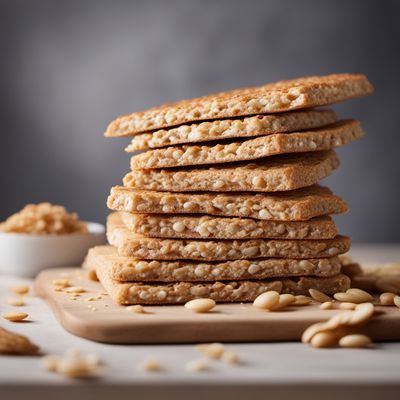
Ingredient
Crisp bread, wheat, wholemeal
Wholesome Wholemeal Crisp Bread
Wholemeal crisp bread is characterized by its crunchy texture, nutty flavor, and rustic appearance. It is a versatile ingredient that can be enjoyed on its own or paired with a variety of toppings, making it a popular choice for light meals or snacks.
Origins and history
Crisp bread, also known as knäckebröd, has its origins in Sweden, where it has been a staple food for centuries. It was traditionally made from rye flour but has evolved to include wholemeal wheat as well. Crisp bread gained popularity due to its long shelf life and ability to withstand harsh climates, making it a reliable source of sustenance for travelers and explorers.
Nutritional information
Wholemeal crisp bread is a good source of dietary fiber, providing around 3 grams per serving. It is also low in fat and contains essential minerals such as iron and magnesium. With approximately 30-40 calories per slice, it is a nutritious and low-calorie option for those watching their weight.
Allergens
Wholemeal crisp bread is made from wheat, which is a common allergen. Individuals with wheat allergies or gluten sensitivities should avoid consuming this ingredient.
How to select
When selecting wholemeal crisp bread, look for options that are made with minimal ingredients and without any artificial additives. Opt for brands that use wholemeal flour as the main ingredient and avoid those with added sugars or hydrogenated oils. Additionally, check for a crisp texture and ensure that the bread is not stale or overly brittle.
Storage recommendations
To maintain the freshness and crispness of wholemeal crisp bread, store it in an airtight container or resealable bag in a cool, dry place. Avoid exposing it to moisture or humidity, as this can cause the bread to become soft or lose its crunchiness. Proper storage will help extend its shelf life for several weeks.
How to produce
Producing wholemeal crisp bread at home requires a mixture of wholemeal flour, water, yeast, and a pinch of salt. The dough is rolled out thinly, pricked with a fork to prevent air bubbles, and baked at a high temperature until crisp and golden brown. With a few simple ingredients and basic baking skills, anyone can enjoy homemade wholemeal crisp bread.
Preparation tips
Wholemeal crisp bread can be enjoyed in various ways. It can be topped with spreads like hummus, avocado, or cream cheese, and garnished with fresh vegetables or herbs. It can also be used as a base for open-faced sandwiches or served alongside soups and salads for added texture and flavor.
Culinary uses
Wholemeal crisp bread is commonly used in Scandinavian cuisine, particularly in Sweden, where it originated. It is also popular in other European countries and is gaining recognition worldwide as a healthy and convenient snack option.
Availability
Wholemeal crisp bread is widely available in supermarkets, health food stores, and specialty stores that carry international products. It can also be purchased online, making it accessible to consumers around the globe.
